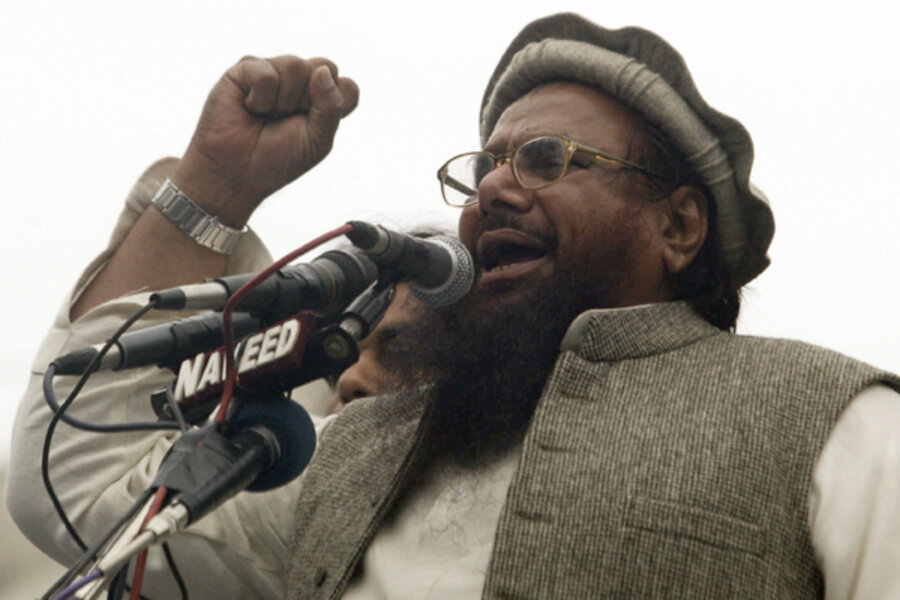With Al Qaeda weakened, US warns about other Pakistani terror groups
Loading...
| New Delhi
With Osama bin Laden dead, and only small numbers of Al Qaeda in Pakistan and Afghanistan, some US leaders are talking up the threat of other militant outfits in the region. Such talk appears aimed at convincing critics why significant US forces must remain in the region at a time of war fatigue.
“The key is making sure there are no safe havens for those transnational terrorist groups in Afghanistan,” Gen. David Petraeus told a reporter days after Mr. bin Laden’s death.
By tallying up groups like Lashkar-e-Taiba, Tehrik-e Taliban Pakistan, and the Haqqani Network, the number of “transnational terrorists” rises from just a few hundred Al Qaeda to thousands of violent extremists to keep an eye on.
These three groups, while they have links with Al Qaeda, have yet to demonstrate much determination and success at striking in the US or Europe. But they could pose a present danger to the US for their ability to trigger a major crisis for nuclear-armed Pakistan, including a war with India.
“We have concerns about them attacking India because that’s the most likely way that we are going to get an India-Pakistan crisis,” says C. Christine Fair, a regional expert at Georgetown University in Washington.
When it comes to sending operatives to hit targets in the West, “I wouldn’t say we’ve seen a lot of stellar capability from these guys,” she adds. But she does worry about their ability to recruit and train members of the Pakistani diaspora living in the West.
The incidents that have most raised international concerns about groups aside from Al Qaeda are the 2008 Mumbai attacks, efforts to attack a Danish newspaper, and the attempted bombing of Times Square.
Who are the Lashkar-e-Taiba (LeT) ?
Lashkar-e-Taiba (LeT), a Pakistani group historically focused on India, chose targets in the Mumbai massacre that were designed to kill not just Indians but Jews and Westerners. Adding to the international dimension, an American named David Headley traveled to Mumbai to plan the attack for the group.
According to Mr. Headley, the LeT also paid for him to travel to Denmark to plan an attack on a newspaper there. But Pakistan’s spy agency known as the ISI pressured the group to shelve the attack.
“That LeT’s leadership contemplated an attack against Denmark is significant, but so too is the fact that it remained susceptible to ISI pressure,” writes LeT expert Stephen Tankel for the New America Foundation.
While most experts see the LeT as focused on India and Kashmir, many worry that another major attack against India would prompt a military conflict requiring US intervention.
Bigger than Al Qaeda - or inflated threats?
That threat is bigger than the threat from Al Qaeda, argued Michael Krepon of the Henry L. Stimson Center before a Senate hearing this month. He said that “we’re the crisis manager” if a “big, ugly, uncontrolled conflict” breaks out between India and Pakistan.
For Mr. Krepon, mitigating this threat requires improving relations with Pakistan and nudging the country toward rapprochement with India and reining in LeT. He argued for fewer troops in Afghanistan due to their marginal ability to affect outcomes there, and because of the stress they put on relations with Pakistan.
General Petraeus is arguing for a robust Afghan troop presence to keep Al Qaeda and these other groups pinned down. If they had freer range into Afghanistan, the theory goes, it would give such groups more ability to plan attacks against the West as well as India and Pakistan.
In Pakistan, there’s concern that the US is “elevating the status of these organizations, making them larger than life” to create a justification for boots on the ground there, says security analyst Imtiaz Gul in Islamabad.
Still, for most Americans, the primary concern is attacks inside the US. The only group aside from Al Qaeda to give it a serious try is the Tehrik-e Taliban Pakistan (TTP).
Who are the Tehrik-e Taliban (TTP)?
The group has declared war against the Pakistani government but also linked up with Al Qaeda and declared it would strike within the US.
When Pakistani-American Faisal Shahzad traveled to Pakistan to join Islamic extremists, the TTP agreed to give him bomb training and sent him home.
The training appeared to have its gaps, however, as the bomb he attempted to set off in Times Square failed to detonate. The close call revealed that, despite all the focus on Pakistan and homeland security, Mr. Shahzad was able to go for training and come back undetected, says Bill Roggio, who runs the Long War Journal website.
Had the bomb worked, it would have killed far fewer than Al Qaeda’s Twin Tower attacks, but “this country would have freaked out,” he says.
It may have been the TTP’s best shot, however. Pakistan-based analysts say the group is on the run from the Army and in serious decline.
“I think for them now to reach out to the West, that’s a very unrealistic assumption,” says Roshtam Shah Mohmand, a former Pakistan ambassador to Afghanistan based in Peshawar.
High-end estimates for TTP put their fighters at 10,000. But the group is scattered, says senior Pakistani reporter Sami Yousufzai. He puts the number at 1,500 who actually have weapons and are near the group’s leader.
Overlapping allegiances
Roggio and Tankel caution against fixating too much on group affiliations since some of the militants have overlapping allegiances and the ability to freelance.
“What are these groups? They’ve trained in the same camps. They’ve fought together. Their leaders sit on the same councils and coordinate operations. So what does that make them?” says Roggio. “Does it require 150,000 troops in Afghanistan? I don’t know to be honest [but] letting them go unfettered is ultimately detrimental to our national security."





